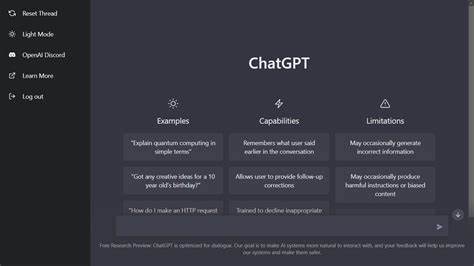
What is ChatGPT? Meaning, Everything you need to know
 What is chatGPT
What is chatGPT
ChatGPT, a remarkable piece of technology developed by OpenAI, has continued to amaze the internet with its AI-generated content.
Initially introduced as a novel chatbot, ChatGPT has since evolved into a tool that is driving the next wave of technological innovation. Despite its impressive capabilities, not everyone is on board with the concept, leaving many to wonder what all the fuss is about.
 What is ChatGPT? Meaning, Everything you need to know
What is ChatGPT? Meaning, Everything you need to know
OpenAI is renowned for its ground-breaking projects, including the development of DALL-E, a text-to-image generator. ChatGPT, a cutting-edge tool that leverages the latest advances in machine learning and natural language processing, is currently available to the public for free. In this article, we’ll delve into what ChatGPT is, how it works, and how it could transform the future of the internet.
 JOIN US ON TELEGRAM
JOIN US ON TELEGRAM
ChatGPT is an AI-based language model that can understand and generate human-like responses to various prompts. It has been trained on a massive corpus of data that includes everything from news articles to literature and social media posts. This extensive training has enabled ChatGPT to learn how to respond to a wide range of inputs, making it an incredibly versatile tool.
READ ALSO: How to use CHATGPT on Telegram
To use ChatGPT, all you need to do is provide it with a prompt, and it will generate a response. The prompt can be anything from a question to a statement, and ChatGPT will generate a human-like response based on its training. The tool’s responses are so natural that it can be challenging to tell whether you’re conversing with a machine or a human.
The potential of ChatGPT is vast. It could revolutionize how we communicate, create content, and consume information on the internet. For instance, ChatGPT could help businesses automate their customer service processes by providing personalized responses to customer inquiries. It could also be used to generate high-quality content for blogs, social media, and other digital platforms.
HOW TO USE CHATGPT EFFECTIVELY
To use ChatGPT, open your browser, Google Chrome, Microsoft Edge, Mozilla Firefox etc. and type chat.openai.com and set up a free account with OpenAI. You can log in with a Google or Microsoft account, or use your email address. During registration, you’ll be prompted to enter a phone number but keep in mind that virtual phone numbers aren’t accepted.
After acknowledging ChatGPT housekeeping rules, including information on data errors, data collection, and feedback submission, you’ll be ready to use the chatbot. Simply type in your text and wait for a response. If the response doesn’t meet your needs, try modifying your prompt or providing additional instructions.
For instance, requesting “Explain how the solar system was made as a middle school teacher” will result in a different response than asking “How was the solar system made.” You can also request specific inputs, such as a four-paragraph essay on Mary Shelley’s Frankenstein.


While ChatGPT strives to provide accurate information, it may fill gaps with incorrect data if there isn’t enough information available. OpenAI notes that such instances are rare, but they can occur. Additionally, ChatGPT has limited knowledge of world events after 2021, as it uses the GPT-3.5 LLM.
COST OF USING CHATGPT
You can use ChatGPT continuously by inputting queries until you close your browser or reset the thread. Additionally, you can choose between dark mode and light mode.
Unlike Bing Chat, which can generate images with Bing Image Creator, ChatGPT can only produce text.
The basic version of ChatGPT is free to use with no limit on usage, but there is a word and character limit for responses. However, it’s not free for OpenAI to run ChatGPT. Initial estimates suggest that it costs around $3 million per month or $100,000 per day, while recent reports indicate that the cost is closer to $700,000 per day.
Furthermore, it has been revealed that OpenAI has taken some extreme measures to train the language model to avoid generating offensive content.
OpenAI also offers a premium version of ChatGPT called ChatGPT Plus, which costs $20 per month. It provides access during peak times, faster responses, and early access to new features such as GPT-4.
WHO INVENTED CHATGPT
CHATGPT was created by a team of researchers at OpenAI, an artificial intelligence research laboratory consisting of some of the leading experts in the field of AI. The team worked to develop CHATGPT, which is based on the GPT-3.5 architecture. GPT-3.5 is a language model that uses deep learning techniques to understand and generate human-like text responses.
The development of CHATGPT involved extensive research, experimentation, and testing to ensure that it could accurately understand and respond to a wide range of questions and topics. The team trained CHATGPT on a massive dataset of text from the internet, books, and other sources to ensure that it could generate high-quality responses.
Since its creation, ChatGPT has become one of the most advanced and widely-used chatbots in the world. It has been used in a variety of applications, from customer service and support to language translation and conversational AI research. Its advanced capabilities and ability to understand natural language make it a valuable tool for many industries and applications.
CAN CHATGPT BE DETECTED BY SCHOOLS, UNIVERSITIES
CHATGPT is an artificial intelligence language model that is designed to simulate human-like conversation. As a software application, it can be accessed through various platforms and devices that are connected to the internet. However, it is important to note that CHATGPT is not designed to deceive or mislead users into thinking that they are conversing with a human being.
Schools and universities may use various software and tools to monitor and detect instances of plagiarism or cheating, but detecting the use of CHATGPT in academic settings is not a common practice. CHATGPT is primarily designed for use in conversational AI research, customer support, and other applications that require natural language processing capabilities.
That being said, the use of chatbots and other AI tools in academic settings is a topic of ongoing discussion and debate. Some educators and researchers believe that these tools can help students learn and improve their writing and communication skills, while others are concerned about the potential for misuse and academic dishonesty. Ultimately, the use of AI tools in academic settings should be evaluated on a case-by-case basis, with consideration given to the potential benefits and risks.
WHEN WAS CHATGPT FIRST RELEASED
CHATGPT was first released in June 2020 by OpenAI, a leading research laboratory in the field of artificial intelligence. It was developed as an improvement over their previous GPT-2 model, with a larger architecture and more advanced language processing capabilities.
CHATGPT’s release was met with a great deal of excitement and interest from the AI research community, as it represented a significant advancement in the development of natural language processing systems. It quickly gained popularity as a tool for chatbot development, customer service, and conversational AI research.
The initial version of CHATGPT, known as GPT-3, was released with an unprecedented 175 billion parameters, making it the largest language model ever created at the time. This allowed it to generate highly sophisticated and contextually relevant responses to a wide range of input prompts.
Since its release, OpenAI has continued to refine and improve CHATGPT’s capabilities, releasing subsequent versions with even larger architectures and more advanced language processing capabilities. Today, CHATGPT remains one of the most advanced and widely-used language models in the world, and it is continuing to push the boundaries of what is possible in the field of natural language processing.
WHAT CAN CHATGPT BE USED FOR?
CHATGPT can be used for a wide range of applications that require natural language processing capabilities. As an artificial intelligence language model, it is designed to simulate human-like conversation and generate text-based responses to a variety of input prompts.
One of the most common uses for ChatGPT is in the development of chatbots and virtual assistants. It can be integrated into messaging platforms, websites, and mobile apps to provide automated customer service and support. By understanding the context and intent of user inquiries, ChatGPT can generate personalized responses that help users find the information they need quickly and efficiently.
CHATGPT can also be used for conversational AI research, allowing researchers to study and test the capabilities of natural language processing systems. It can be used to develop and test algorithms for text generation, question answering, and sentiment analysis, among other applications.
Another potential use for CHATGPT is in language translation. By understanding the context and nuances of different languages, CHATGPT can be used to generate accurate translations that capture the meaning and tone of the original text.
Overall, CHATGPT’s advanced language processing capabilities make it a valuable tool for a wide range of industries and applications, from customer service and support to healthcare, finance, and education. As technology continues to evolve, it is likely that we will see even more innovative applications of CHATGPT and other natural language processing systems in the future.
CAN CHATGPT REPLACE GOOGLE?
CHATGPT and Google are two very different tools with different purposes and functions. While Google is a search engine that provides users with access to vast amounts of information from the internet, CHATGPT is an artificial intelligence language model that is designed to simulate human-like conversation and generate text-based responses to a variety of input prompts.
While CHATGPT is capable of understanding natural language and generating sophisticated responses to a wide range of questions and topics, it does not have the same breadth and depth of knowledge as Google. Google is able to provide users with access to a vast array of information, including news articles, academic research, and multimedia content.
That being said, there are some situations where CHATGPT may be a more appropriate tool than Google. For example, if a user is looking for personalized customer service or support, CHATGPT can be integrated into messaging platforms, websites, and mobile apps to provide automated assistance. Additionally, CHATGPT may be more effective at answering complex or nuanced questions that require a deeper understanding of context and intent.
Overall, it is unlikely that CHATGPT will replace Google as a search engine. However, it may complement Google and other search engines by providing more personalized and contextually relevant responses to specific questions and topics. As natural language processing technology continues to advance, it is likely that we will see even more innovative applications of CHATGPT and other language models in the future.
WHAT IS AUTO-GPT?
Auto-GPT, also known as Automatic Generative Pre-training Transformer, is an advanced AI language model developed by OpenAI. It is a variant of the GPT family of language models, which are designed to simulate human-like conversation and generate text-based responses to a variety of input prompts.
Auto-GPT is unique in that it is designed to be self-supervised, meaning it can learn from large amounts of unlabelled data without the need for explicit supervision. This allows it to improve its language processing capabilities over time, and generate more sophisticated and contextually relevant responses to a wide range of input prompts.
One of the key features of Auto-GPT is its use of unsupervised learning techniques, such as contrastive learning and momentum contrastive learning. These techniques enable the model to learn from large amounts of unlabeled data, such as text documents and other unstructured data sources. By doing so, it can gain a deeper understanding of natural language and improve its language processing capabilities.
Auto-GPT has a range of potential applications, including chatbot development, virtual assistants, and conversational AI research. It can be used to generate personalized responses to user inquiries, provide automated customer service and support, and improve the efficiency of language translation and sentiment analysis.
Overall, Auto-GPT represents a significant advancement in the field of natural language processing and is helping to push the boundaries of what is possible with AI language models. As technology continues to evolve, it is likely that we will see even more innovative applications of Auto-GPT and other advanced language models in the future.
WHAT IS THE FUTURE OF CHATGPT?
CHATGPT has already made significant strides in the field of natural language processing, and its future is bright. As technology continues to evolve, it is likely that we will see even more innovative applications of CHATGPT and other advanced language models.
One potential area of growth for ChatGPT is the development of more sophisticated chatbots and virtual assistants. As businesses and organizations seek to provide more personalized and efficient customer service and support, the demand for AI-powered chatbots and virtual assistants is likely to grow. ChatGPT’s advanced language processing capabilities make it an ideal tool for these applications, and it is likely that we will see even more sophisticated and contextually relevant chatbots and virtual assistants in the future.
Another area of growth for ChatGPT is in the development of language translation and sentiment analysis tools. As more businesses and organizations operate on a global scale, the demand for accurate and efficient language translation tools is likely to grow. ChatGPT’s ability to understand natural language and generate sophisticated responses makes it well-suited for these applications, and we can expect to see more innovative language translation and sentiment analysis tools in the future.
As the technology behind ChatGPT continues to evolve, we may also see new applications of the technology in fields such as healthcare, finance, and education. For example, ChatGPT could be used to develop more sophisticated patient monitoring and diagnostic tools or to provide more efficient and personalized financial advice and support.
Overall, the future of ChatGPT is bright, and we can expect to see continued growth and innovation in the field of natural language processing in the years to come.
If you found this blog post on What is ChatGPT? Meaning, Everything you need to know, kindly share with others.



